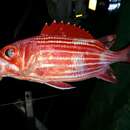Diagnostic Description
provided by Fishbase
Body with alternating about stripes of red and silvery white; head red; operculum with silvery reflections, a white streak from above edge of upper jaw to the corner of pre, and a narrow white band on posterior edge of preopercle. Five oblique scale rows on cheek; body depth 2.7-3.1 in SL; head length (HL) 2.55-2.75 in SL; snout length 3.85-4.15 in HL; interorbital width 4.8-5.15 in HL; maxilla extending from below front of the pupil nearly to center of the eye, upper jaw length 2.55-2.8 in HL; premaxillary groove at least to a vertical at front edge of the orbit; rounded anterior end of nasal; medial margin of nasal bone spineless; small nasal fossa without spinules on margin; slight ridge along the upper edge of suborbital bones smooth anteriorly, slightly serrate below posterior part of eye; preopercular spine, 5.4-7.1 in HL; 2 opercular spines (1 specimen with a large opercular spine), the lower 1/2 to 2/3 length of the upper spine; 4th dorsal spine usually longest, 2.2-2.55 in HL; 3rd anal spine 1.5-2.05 in HL (Ref. 27370).
- Recorder
- Estelita Emily Capuli
Morphology
provided by Fishbase
Dorsal spines (total): 11; Dorsal soft rays (total): 13 - 14; Analspines: 4; Analsoft rays: 9
- Recorder
- Estelita Emily Capuli
Trophic Strategy
provided by Fishbase
At daytime, this holocentrid aggregates in crevices and under overhangs of basalt reefs in water deeper than 6 m, but especially below 20 m. It ranges out from its shelter into the surrounding areas after dark. Solitary individuals are active close to rock, coral, or pockets of sand. By first morning light it has returned to its daytime retreats (Ref. 13550).
Biology
provided by Fishbase
Inhabits seaward reefs below the surge zone, common near caves and ledges (Ref. 9710). Feeds mainly on crustaceans.
Sargocentron xantherythrum: Brief Summary
provided by wikipedia EN
Sargocentron xantherythrum, commonly known as Hawaiian squirrelfish or striped squirrelfish, is a member of the squirrelfish family that is endemic to the Hawaiian Islands. It occasionally makes its way into the aquarium trade. It grows to a length of 17 centimeters (6.7 in).
- license
- cc-by-sa-3.0
- copyright
- Wikipedia authors and editors
Habitat
provided by World Register of Marine Species
Known from seamounts and knolls
Stocks, K. 2009. Seamounts Online: an online information system for seamount biology. Version 2009-1. World Wide Web electronic publication.
- license
- cc-by-4.0
- copyright
- WoRMS Editorial Board

